| dc.description.abstract | In the city of Jakarta, the students, working class or any people needing to commute within the city have the option to take the private-owned vehicle or the public mass transport. The private-owned vehicle consists of cars and motorcycles, with 75% of them are motorcycles. The main public transport in Jakarta is the commuter train and bus rapid transit (BRT) system, with BRT system have their own lane in the public roads. Unfortunately, the recorded number for accidents is still in the range of thousands for private vehicle, hundreds for bus rapid transit; and while the commuter train has low number of accidents, it still records some severe accidents. We would like to assess the risk attached to the commuting activities, and quantitative risk assessment (QRA) is used as the method.
To perform QRA within the transportation world, we first established the framework with the basis risk analysis principles from Aven (2012) and some studies on vehicle accidents. First, the context must be established, as this step contains the defining basis of the assessment. Then, the hazard should be identified for the starting point of accident cause and consequence analysis. In the cause analysis, three common main sources of accident should be included: human error, environmental factor and vehicle mechanical failure. Consequence analysis should include the intermediate events identified that may escalate the accident, some of the events are, vehicle speed, the functionality of safety feature, traffic situation and passenger condition on vehicle. The results from cause and consequence analysis are presented in the risk picture. Monitoring, review and update are important to keep the validity of the assessment, while communication and consultation are critical to understand the view of every stakeholder involved
As the results of QRA, 4 risk indices are calculated: the crash occurrence probability, potential injuries and loss of lives, individual injury risk and individual fatality risk. Our assessment result shows that the private vehicles have lower probability of crash (expected probability of 3.44 × 10-7 for cars and 3,81 × 10-7 for motorcycles) than the BRT system (5,36 × 10-5) and commuter train (6,26 × 10-6). Potential injuries from commuter train (40) and BRT (5,2) are also the higher than the private vehicles, this is due to the maximum number of passengers the vehicle can carry. The same reason also applies to why the commuter train have the highest potential loss of lives, considering how much passengers the train can carry. These numbers imply that when a public transport is having an accident, the outcome will be more severe. Individual injury and fatality risk are the indices that shows the risk to one passenger/occupant of the vehicle when travelling one time. The results in individual injury risk for BRT system is the highest (1,13 × 10-5) almost 25 times more than motorcycles (3,93 × 10-7), the lowest in individual injury risk. Highest individual fatality risk is with the motorcycles (5,84 × 10-7) and the lowest is the commuter train (1,02 × 10-8). Overall, we have injury risk higher than the fatality risk for every individual.
We introduced some of the possible risk reducing measures with the focus to reduce the crash frequency. Violating traffic rule on the road (private vehicles) and bad systems (public transport) are the most significant in causing the crash. From this thinking, we understand that risk reducing measures for vehicle accident will be effective in the form of a more robust regulations (for private vehicles) and a better-designed system (for public mass transport). | nb_NO |

